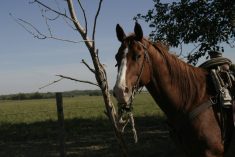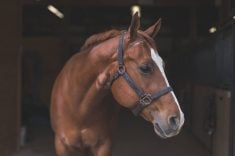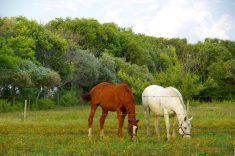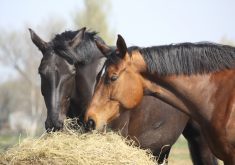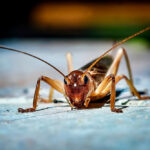So much detriment comes to the horse when its feet are not comfortable.
The robust development and expression of the back half of the horse’s hoof and by association, the frog, plays a major role in cushioning a comfortable landing of the equine foot.
The weak or ‘sick’ frog has become so common that its appearance is often overlooked but it offers a wealth of information.
The frog is a triangular-shaped elastic cushion that spans the back two-thirds of the hoof’s solar surface. The base of the healthy frog is particularly broad and its width will be 50 to 60 per cent of its length.
Read Also

An unbelievable tale of a lost engagement ring
After nearly 50 years, a southern Alberta farmer finds her wedding ring in an unusual place.
When healthy and robust, its appearance is almost heart shaped. The callused frog merges with the bulbs of the heels and extends over half the distance of the hoof to the toe with its central apex ideally ending in the front third of the hoof. At the centre of a healthy frog is a wide groove (or central sulcus) which a thumbprint fits into easily.
A healthy frog also has ‘depth’ and/or substance, and ideally reaches the ground upon weight bearing. Ground contact is crucial to the sensory input that stimulates, develops and conditions the tissues at the back of the horse’s foot of which the frog is a key component. Recent research has shown the frog to be rich in the proprioceptive receptors that give the horse an awareness or feel of where its feet and body are in space.
The frog is also rich in scent and sweat glands. When healthy, the mass of the frog dominates the back half of the hoof. Its prominence and presence is substantial.
An underdeveloped or weak frog, on the contrary will appear recessed, ‘shrivelled’ and/or shrunken, misshapen, narrow and contracted. The central sulcus will contract and become a deep fissure that migrates backwards. It will then be seen as a spilt going up in between the bulbs of the heels.
Since this recessed area can no longer self-clean itself, the environment for a pathogenic condition called thrush becomes ideal. The unhealthy frog is often afflicted with various degrees of thrush. This split is commonly associated with heel pain and often leads to pathological toe-first landings. Although many topical products effectively treat and retard thrush in the short term, troubles continue to return. Healthy frogs are simply not vulnerable to thrush.
The external appearance of the frog is strongly linked to the development of an internal structure known as the digital cushion which lies on the inner side of the frog.
The digital cushion is a fibro-fatty structure with an intricate network of highly organized connective tissue with fascial and fibrous bands that ‘sling’ the back half of the horse’s foot. The digital cushion is structural, positioned between the two lateral cartilages at the back of the foot and thus offers the horse a type of rebounding action upon load bearing — similar to that of a trampoline.
When the digital cushion is well developed and strong, the heel bulbs will be full and round, and the tissue at the heel will feel firm (like that of a tennis ball). Since the digital cushion and/or bulbs of the heel and the frog function and develop as a unit, their physical appearances will parallel one another. In a sense we can ‘judge a book by its cover.’
Horses with thick, healthy frogs and a heel-first landing will be able to cushion the delicate navicular region and promote blood circulation within the hoof as well as within the entire horse. If the frog is weak and recessed, the internal tissues of the hoof are left vulnerable to injuries.
Hoof boots and horseshoes serve as an artificial means to protect this area. These devices bring comfort to the back of the foot by lifting the sensitive internal structures off the ground and in a sense protect the already weakened tissues. An alternative way of reinforcing the horse’s own capabilities to protect this area is to provide the horse with the means and resources to forge their own frog/s for which they are totally capable of doing and adapted for.
It is critical to place the frog into ‘work.’ Thousands of heel-first landings are needed to build an adequate inner ‘cushion’ structure and condition the frog.
A good frog can be neither trimmed nor carved onto the horse’s foot — rather it must be stimulated into development from the inside. True to its amphibian namesake, the frog goes through a natural shedding or exfoliation once or twice a year (particularly in the springtime). Under the ‘old’ shed will be a new vibrant frog and prematurely trimming can predispose the horse to unnecessary sensitivity. Prudent trimming of the frog and in many cases no trimming needs to take priority over ‘neatening’ or ‘prettying’ it up.
Living conditions that incorporate a four-inch bed of pea gravel for horses to loaf on or travel through as part of their daily routines will condition remarkable development of the frog as the gravel substrate engages it to participate in ground contact. So in a sense, a prescription for rocks is indeed the doctor’s orders.





